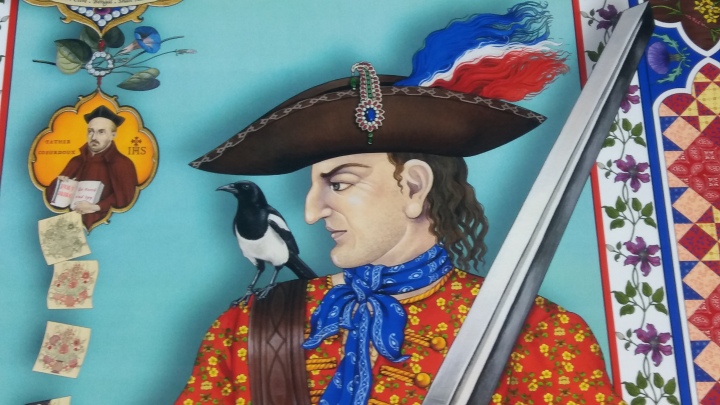I first met the Singh Twins many years ago when I was studying at the University of Manchester and took a course entitled ‘Religion and the Arts’. Amongst the participants were the Singh Twins and it was clear then that they were destined for higher things. It was an excellent inter-disciplinary course that engaged very directly with art in religious contexts and covered such areas as Christian and Islamic architecture, Greek Art, Buddhist Gandhara sculpture, Russian Orthodox icons and much more. It was wide ranging and took the students out of the lecture room and into religious buildings and other places. It had a great influence on me and I suspect it must have had an influence on the Singh Twins who are now such established artists.

Ancient Roots: The Wonder that was India
Details from Ancient Roots
I was glad, by chance, to get the chance to see this exhibition which is both beautiful and challenging at the Walker Art Gallery in Liverpool. It is a very impressive exhibition. The painterly skills of the twins are well displayed in these new works and the display of eleven of the major pieces on digital lightboxes enhances the effect tremendously. Even these photographs snapped on my camera phone help to show something of the power of their art. Each of these works depicts an historical figure (ten of them women) who wear a different textile. Around the central figure are depicted aspects of the process of production and trade of that fabric.

Chintz: The Price of Luxury. Depicting Queen Catherine of Braganza who married Charles II in 1662 bringing Bombay (Mumbai) as part of her dowry
The exhibition explores the history of Indian textiles in the context of empire, enslavement and exploitation and the way high fashion has always been intimately bound up with unequal terms of trade between western society and the lands where most of these textiles are produced.

Indiennes: The Extended Triangle. Depicting the slave trade
They have such an eye for detail and incorporate in each of the eleven major works vignettes from the history of the interaction between luxury consumption, trade, and imperialism. It asks so many questions about ethical trade and the history of consumerism and Liverpool is such an appropriate place for this appear. The image at the top of this page is a detail taken from their work ‘Cotton: Threads of Change’, a raw material produced originally in India and central to the economic development of Liverpool as a port as part of the ‘Atlantic Trade’.

Cotton: Threads of Change
The bottom of ‘Cotton’ shows an imagined historical skyline of Liverpool which begins symbolically in China and Egypt and ends in New York. Some of the buildings of Liverpool fly the Confederate flag, a pointed but accurate assertion for a city that was so tied to slavery for so long and which in many cases supported the South in the American Civil War. A grand ball was held by the citizenry in St George’s Hall to support the Confederacy.

Calico: Merchant Thieves (detail)
Some of the new paintings feature Theresa May, Boris Johnson, Angela Merkel and Donald Trump and in one room is a large collection of objects from around the world from the Museum’s collection which shed further light on the history and issues bound up in this interaction between fashion, empire and trade. There are also preparatory works in the show and time-lapse films of the works being created.

Silks and Quilts: Exploration and Exploitation. Queen Isabella of Castile
It is an incredibly impressive and thought provoking exhibition which I am glad I got to see. It is in Liverpool until 20th May 2018 after which it will move to Wolverhampton Art Gallery from 21st July to 16th September.


Details from Silks and Quilts
























